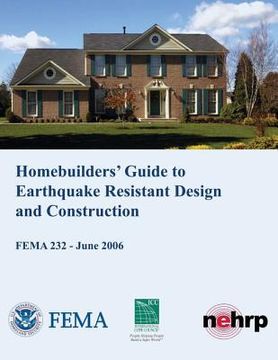Homebuilders' Guide to Earthquake-Resistant Design and Construction (FEMA 232 / June 2006) (en Inglés)
Reseña del libro "Homebuilders' Guide to Earthquake-Resistant Design and Construction (FEMA 232 / June 2006) (en Inglés)"
The Federal Emergency Management Agency (FEMA), which is part of the Department of Homeland Security, works to reduce the ever-increasing cost that disasters inflict on the nation. Preventing losses before they occur by designing and constructing buildings and their components to withstand anticipated forces from various hazards is one of the key components of mitigation and is one of the most effective ways of reducing the cost of future disasters. The National Earthquake Hazards Reduction Program (NEHRP) is the federal program established to address the nation's earthquake threat. NEHRP seeks to resolve two basic issues: how will earthquakes affect us and how do we best apply our resources to reduce their impact on our nation. The program was established by Congress under the Earthquake Hazards Reduction Act of 1977 (Public Law 95-124) and was the result of years of examination of the earthquake hazard and possible mitigation measures. Under the NEHRP, FEMA is responsible for supporting program implementation activities, including the development, publication, and dissemination of technical design and construction guidance documents. Generally, there has not been much technical guidance addressing residential buildings unless they are located in areas of high seismicity or exceed a certain size or height. This is because most residential buildings were thought to perform fairly well in earthquakes due to their low mass and simple construction. While buildings may not normally experience catastrophic collapse, they can still suffer significant amounts of damage, rendering them uninhabitable. This is especially true when construction techniques are less than adequate. What is particularly important from FEMA's point of view is that, given the sheer number of this type of building, even minor damage represents a significant loss potential and temporary housing demand that will need to be addressed after an earthquake by all levels of government. This guide provides information on current best practices for earthquake-resistant house design and construction for use by builders, designers, code enforcement personnel, and potential homeowners. It incorporates lessons learned from the 1989 Loma Prieta and 1994 Northridge earthquakes as well as knowledge gained from the FEMA-funded CUREE-Caltech Woodframe Project. It also introduces and explains the effects of earthquake loads on one- and two-family detached houses and identifies the requirements of the 2003 International Residential Code (IRC) intended to resist these loads. The stated purpose of the IRC is to provide: "... minimum requirements to safeguard the public safety, health, and general welfare, through affordability, structural strength, means of egress facilities, stability, sanitation, light and ventilation, energy conservation and safety to life and property from fire and other hazards attributed to the built environment." Because the building code requirements are minimums, a house and its contents still may be damaged in an earthquake even if it was designed and built to comply with the code. Research has shown, however, that earthquake damage to a house can be reduced for a relatively small increase in construction cost. This guide identifies above-code techniques for improving earthquake performance and presents an estimate of their cost. Note that the information presented in this guide is not intended to replace the IRC or any applicable state or local building code, and the reader is urged to consult with the local building department before applying any of the guidance presented in this document. The information presented in this guide applies only to one- and two-family detached houses constructed using the nonengineered prescriptive construction provisions of the IRC. Applicable IRC limits on building configuration and construction are described.

